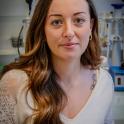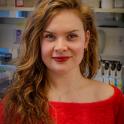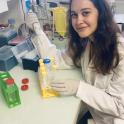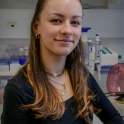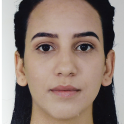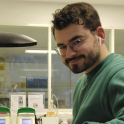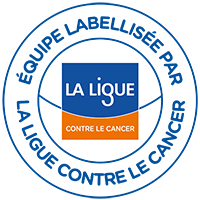Published on 23.10.2025
Presentation
The Hematology Laboratory at the Imagine Institute focuses on both the physiopathology and treatment of malignant and benign hematologic disorders. The laboratory is part of the INSERM U1163 research unit and works in close collaboration with the clinical hematology department of Necker Hospital, as well as national reference centers for mastocytosis (CEREMAST), immunodeficiencies (CEREDIH), and hemoglobinopathies.
Since January 2025, the laboratory has been led by Prof. Olivier Hermine and Dr. Thiago Trovati Maciel.
Our main objectives are:
- Characterizing the mechanisms underlying hematologic disorders;
- Developing innovative therapeutic strategies;
- Advancing clinical research;
- Facilitating technology transfer.
We collaborate closely with several Necker Hospital departments, including pathology, biology, cytogenetics, molecular biology, biotherapy, infectious diseases, transplantation, and pediatric immune hematology.
Erythropoiesis regulation and its clinical applications
Red blood cells (RBCs) are essential for oxygen transport, and their production (erythropoiesis) must be tightly regulated. Genetic disorders such as beta-thalassemia and sickle cell disease (SCD) are prime examples of conditions where this process is disrupted. Both are characterized by ineffective and defective erythropoiesis, leading to chronic anemia and severe complications that affect millions of people worldwide.
Our laboratory has a long-standing commitment to understanding and treating these diseases. In particular, we played a pioneering role in the pre-clinical development of sotatercept and luspatercept, two groundbreaking therapies that target TGF-β superfamily signaling to restore effective erythropoiesis. The conceptual and experimental groundwork established in our lab was instrumental in bringing these molecules into clinical trials, ultimately leading to their therapeutic use in beta-thalassemia. This translational success exemplifies our ability to move discoveries from bench to bedside and to deliver real impact for patients.
Our current projects extend these efforts through several complementary approaches:
- Molecular regulation of red blood cell development: we study how caspases, serotonin metabolism, and the TGF-β1 axis orchestrate erythroid differentiation. Dysregulation of these pathways is a major contributor to ineffective erythropoiesis in genetic blood disorders.
- Genetic determinants of red blood cell diseases: by performing genomic and functional studies, we continue to identify novel genetic defects that alter erythropoiesis. Such findings not only explain variability in patient outcomes but also point toward new therapeutic targets.
- Therapeutic innovation: building on our pioneering work with luspatercept and sotatercept, we are exploring additional strategies to correct ineffective erythropoiesis. These include pharmacological approaches to mobilize intracellular iron pools or to modulate erythroid transcriptional networks. Our collaborations with biotech and pharmaceutical partners ensure that promising discoveries are rapidly translated into clinical development.
- Linking erythropoiesis to innate immunity: beyond red cell biology, we investigate how inflammatory pathways and immune cells—including mast cells and basophils—contribute to complications in sickle cell disease. These insights directly connect to our RHU Sickmast project, where immune regulation and erythropoiesis are studied in an integrated framework.
By combining fundamental discoveries, genetic insights, and therapeutic innovation, our laboratory continues to advance the field of erythropoiesis research. Our pioneering contributions to sotatercept and luspatercept demonstrate the transformative potential of our approach, with the goal of developing the next generation of treatments for patients with beta-thalassemia, sickle cell disease, and related disorders.
Immuno-oncology
Our laboratory also investigates the crossroads of immunity, inflammation, and cancer. Some of our projects explore how genetic immune deficiencies predispose patients to rare lymphomas or how autoimmune conditions such as celiac disease can evolve into lymphoproliferative disorders.
Key directions include:
- Building one of the largest databases of patients with inborn errors of immunity and malignant complications, in collaboration with national networks.
- Developing targeted therapies, including antibodies and CAR-T cell approaches, to treat lymphomas arising in the gut and other sites.
- Using comparative models (such as feline gastrointestinal lymphomas) to better understand disease mechanisms.
Although these conditions are rare, they represent significant unmet medical needs. By integrating immunology, oncology, and hematology, we aim to design innovative treatments tailored to specific genetic and molecular contexts.
Mastocytosis and role of mast cells in disease
Mastocytosis is a rare and heterogeneous disease caused in most cases by mutations in the KIT receptor. It leads to an abnormal accumulation and activation of mast cells, which are immune cells involved in allergic and inflammatory responses.
Through the CEREMAST national reference center, our laboratory has access to clinical data from more than 2,000 patients, making it the largest European database for this disease. This unique resource allows us to:
- Explore how KIT mutations cooperate with other genetic alterations to drive disease severity.
- Identify new molecular pathways (such as hedgehog signaling or FAS-mediated apoptosis) that could be targeted for therapy.
- Test novel therapeutic strategies, including kinase inhibitors and combinations designed to overcome resistance.
- Investigate hereditary forms of mastocytosis through family-based genetic studies, with the goal of discovering new disease genes.
Beyond mastocytosis, we also study the role of mast cells in other diseases, ranging from autoimmune conditions and allergies to neurodegenerative disorders. This broad perspective highlights mast cells as key players in health and disease.
Spotlight on the RHU Sickmast Project
One of our flagship initiatives is the RHU Sickmast project, funded under the French “Recherche Hospitalo-Universitaire” (RHU) program. This ambitious, multi-disciplinary effort is coordinated by Prof. Olivier Hermine, with Dr. Thiago Trovati Maciel as Scientific Director, and Professors Slimane Allali and Jean-Benoît Arlet directing the clinical program.
The Challenge
SCD is one of the most common genetic disorders worldwide. It is caused by a mutation in the hemoglobin gene, leading to misshapen red blood cells, chronic anemia, and painful vaso-occlusive crises. These crises are not only life-threatening but also severely affect quality of life. Despite progress in patient care, many complications remain unpredictable and poorly controlled.
Our Hypothesis
Traditionally, SCD has been viewed as a red blood cell disorder. However, our recent findings suggest that mast cells—immune cells best known for their roles in allergy and inflammation—may play a central role in orchestrating both acute and chronic complications of SCD. We have shown that mast cell mediators are elevated during acute chest syndrome, one of the most severe complications of SCD. This points to mast cell activation as potential driver of disease progression.
Objectives of Sickmast
The RHU Sickmast project aims to:
- Establish a large clinical and biological database of SCD patients, in collaboration with our translational network and partners such as InIdex GR-Ex.
- Identify biomarkers of mast cell activation that correlate with acute and chronic SCD complications. This will help us predict which patients are at risk and intervene earlier.
- Develop new therapeutic strategies targeting mast cells, and their mediators. Candidate treatments include existing drugs, such as tyrosine kinase inhibitors.
- Conduct preclinical and clinical studies to test these approaches and assess their ability to prevent vaso-occlusive crises, reduce inflammation, and improve patient outcomes.
Impact
By redefining SCD as not only a red blood cell disorder but also an immune-mediated disease, Sickmast has the potential to transform how we predict, prevent, and treat complications. Beyond improving patient care, the project will generate valuable intellectual property and foster collaborations with industry, ensuring that discoveries translate rapidly to the clinic.

Team
Resources & publications
-
 2020Journal (source)Leukemia
2020Journal (source)LeukemiaTargeted deep sequencing reveals clonal and subclonal mutational signatures i...
-
 2020Journal (source)Haematologica
2020Journal (source)HaematologicaInnate immune cells, major actors of sickle cell disease pathophysiology.
-
 2020Journal (source)Front Microbiol
2020Journal (source)Front MicrobiolNovel Treatments of Adult T Cell Leukemia Lymphoma.
-
 2019Journal (source)Cell Rep
2019Journal (source)Cell RepEnhanced Renewal of Erythroid Progenitors in Myelodysplastic Anemia by Periph...
-
 2019Journal (source)Haematologica
2019Journal (source)HaematologicaXPO1 regulates erythroid differentiation and is a new target for the treatmen...
-
 2019Journal (source)Haematologica
2019Journal (source)HaematologicaA novel, highly potent and selective phosphodiesterase-9 inhibitor for the tr...
-
 2019Journal (source)F1000Res
2019Journal (source)F1000ResRecent advances in the understanding and therapeutic management of mastocytosis.
-
 Journal (source)J Allergy Clin Immunol Pract
Journal (source)J Allergy Clin Immunol PractNeuroinflammatory disorders and mastocytosis: A possible association?











